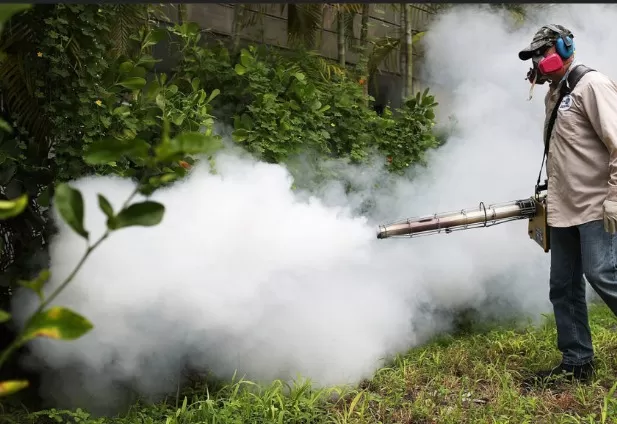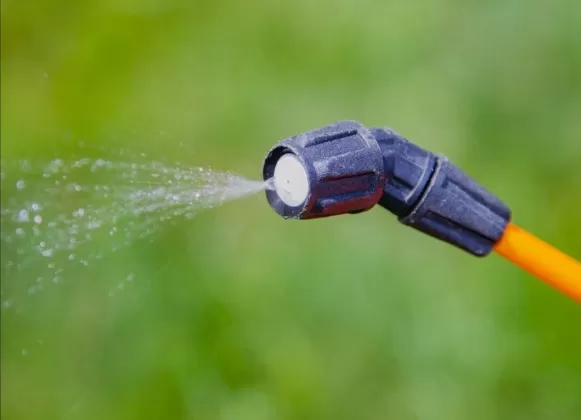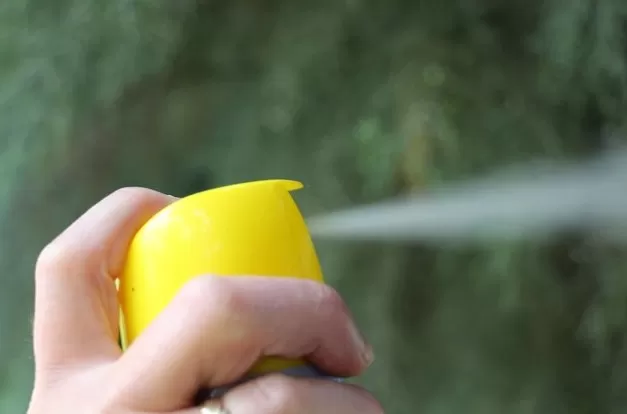Pesticide-Free Gardening: Reasons to Skip Chemicals. Modern pesticides have undoubtedly revolutionized the ability of home gardeners to achieve well-maintained landscapes and lush lawns through chemical management.
However, it is essential to consider the drawbacks and potential negative impacts associated with pesticide use before deciding to incorporate them into your yard. Here are some important points to be aware of:
The Hazards of Non-Specific Pesticides in Residential Settings: Safeguarding Pollinators for a Flourishing Environment

Many pesticides commonly used in residential homes and gardens lack specificity, meaning they not only target the intended pests but also harm beneficial insects.
Take aphids, for example. When combating an aphid infestation with a non-specific pesticide, it’s important to recognize that it won’t solely eliminate the aphids.
Instead, it will indiscriminately affect any insect that comes into contact with the pesticide-treated plant. Consequently, valuable pollinators such as bees and butterflies, which are vital for the growth and reproduction of plants, are put at risk.
Pollinators play a crucial role in the natural world by aiding in the pollination process, allowing plants to thrive and produce fruits, vegetables, and beautiful flowers.
It is common knowledge among knowledgeable gardeners that preserving pollinator populations is of utmost importance. However, the use of non-specific pesticides jeopardizes the delicate balance of the ecosystem and endangers these invaluable pollinators.
By extending our understanding of this issue, we recognize the potential hazards posed by non-specific pesticides.
These chemical treatments not only eradicate pest populations but also disrupt the intricate web of life within our immediate environment. Therefore, it is imperative to adopt sustainable pest management practices in residential settings to ensure the protection of pollinators and maintain the overall health of our gardens and surrounding ecosystems.
Preserving a diverse array of pollinators requires a shift towards alternative pest control methods that are environmentally friendly and pose minimal risks to non-target organisms.
Integrated pest management (IPM) techniques, for instance, emphasize the use of biological controls, natural predators, and selective pesticides. By implementing these approaches, homeowners and gardeners can effectively address pest issues while minimizing harm to beneficial insects like pollinators.
In conclusion, it is crucial to acknowledge the potential dangers associated with non-specific pesticides in residential homes and gardens.
The well-being of pollinators, such as bees and butterflies, is at stake when these broad-spectrum chemicals are used. To protect these essential creatures and ensure a flourishing environment, it is essential to adopt sustainable pest management practices that prioritize the preservation of pollinator populations and the overall health of our ecosystems.
Minimizing the Impact of Water Run-Off: Safeguarding Water Ecosystems and Enhancing Sustainable Gardening Practices
The continuous application of pesticides poses a significant threat as these chemicals can find their way into rivers and streams through water run-off.
It is crucial to consider the implications on your neighborhood and the local environment before resorting to spraying, as it can unintentionally harm the delicate creatures residing in the nearby water ecosystems. Taking responsible actions not only aligns with ethical principles but also yields indirect benefits for your garden. Remember, the organisms inhabiting and relying on these water ecosystems often feed on insects, contributing to the natural regulation of local insect populations.
The detrimental consequences of pesticide run-off on water ecosystems cannot be underestimated.
When pesticides are applied excessively or inappropriately, they can be carried away by rainwater or irrigation runoff, eventually entering nearby water bodies. Once introduced into aquatic environments, these toxins can have severe impacts on aquatic organisms, including fish, amphibians, and invertebrates.
These organisms play vital roles in maintaining the balance and health of the water ecosystems, and their well-being is intricately linked to the overall ecological stability.
By recognizing the potential harm caused by pesticide run-off, we can take proactive measures to minimize its negative effects.
Instead of solely focusing on the immediate pest control benefits for our gardens, it is essential to adopt a broader perspective that encompasses the well-being of the surrounding environment. Choosing alternative pest management strategies that are environmentally friendly and pose minimal risks to water ecosystems is a responsible course of action.
Integrated pest management (IPM) provides a holistic approach to pest control that prioritizes long-term sustainability.
By incorporating a combination of methods such as cultural practices, biological controls, and targeted pesticide applications, we can effectively manage pests while reducing the overall reliance on chemical treatments. Implementing IPM not only helps safeguard water ecosystems but also promotes a healthier garden ecosystem by preserving natural predators and maintaining ecological balance.
Furthermore, fostering a conscious connection between our actions and the environment can yield additional benefits for our gardens.
The creatures that inhabit the water ecosystems near our homes often contribute to natural pest control by preying on insects. By protecting and preserving these organisms, we create a harmonious ecosystem where natural checks and balances can thrive.
Beneficial insects, such as dragonflies and damselflies, may rely on water sources for their life cycle stages, acting as voracious consumers of garden pests. By safeguarding water ecosystems, we indirectly enhance the resilience of our gardens through the ecological services provided by these natural allies.
In conclusion, being mindful of the potential risks associated with water run-off from pesticide use is essential for the well-being of water ecosystems near our homes.
By adopting sustainable pest management practices, such as integrated pest management, we can minimize the negative impact on aquatic organisms while maintaining effective pest control in our gardens. Embracing a holistic approach that considers the interconnectivity of ecosystems not only preserves the delicate balance of water ecosystems but also enhances the overall sustainability and resilience of our gardens.
Prioritizing Pet Safety: Understanding the Dangers of Pesticides and Their Impact on Pets

Following the application of pesticides, a specific period of time must elapse during which it is crucial to avoid contact with the treated lawn to prevent exposure to potentially hazardous chemicals.
However, pets face an increased risk as they may not have the ability to refrain from chewing on treated grass or licking their coats, which could lead to the ingestion of toxic substances transferred through contact.
It is essential to acknowledge the potential dangers posed by pesticides to our beloved pets.
These chemical treatments, designed to control pests and enhance the appearance of our lawns, can have unintended consequences on the well-being of our furry companions. Pets, especially dogs and cats, are naturally curious and may be tempted to chew on or ingest grass that has been recently treated with pesticides.
Additionally, when they groom themselves, there is a risk of them ingesting toxic chemicals that may have been transferred to their fur during contact with treated surfaces.
The adverse effects of pesticide exposure on pets can range from mild discomfort to severe health complications.
Common symptoms of pesticide poisoning in animals may include gastrointestinal distress, neurological problems, respiratory issues, skin irritations, and even organ damage. In extreme cases, exposure to certain pesticides can be fatal.
As responsible pet owners, it is our duty to ensure their safety and well-being by taking appropriate precautions when using pesticides in our outdoor spaces.
To protect our pets from the hazards of pesticides, it is vital to consider alternative approaches that prioritize their health and minimize potential risks.
Integrated pest management (IPM) techniques can be particularly beneficial, as they focus on long-term pest control strategies that minimize the need for chemical treatments. Implementing IPM involves utilizing preventive measures, such as maintaining a healthy lawn through proper watering and mowing practices, promoting natural predators, and employing targeted treatments only when necessary.
When applying pesticides, it is crucial to adhere to the recommended safety guidelines provided by the manufacturer.
This includes keeping pets away from treated areas during the designated re-entry period, which allows sufficient time for the chemicals to dry or dissipate. Additionally, consider using pet-friendly or organic alternatives to conventional pesticides whenever possible.
These alternatives are formulated to be less harmful to pets and can help mitigate the risks associated with chemical exposure.
Regularly monitoring our pets for any signs of pesticide-related illness is equally important.
If you notice any unusual behavior, symptoms, or suspect that your pet may have come into contact with pesticides, it is essential to seek veterinary care immediately. Prompt action can make a significant difference in mitigating the potential harm caused by pesticide exposure and ensuring the well-being of our cherished companions.
In conclusion, understanding the hazards that pesticides pose to our pets is paramount for their safety and overall health.
By adopting pet-conscious pest control practices, such as integrated pest management and the use of pet-friendly alternatives, we can minimize the risks associated with pesticide exposure. Practicing responsible pesticide application, adhering to safety guidelines, and seeking veterinary assistance when needed are essential steps to safeguard our pets from the potential harms posed by these chemicals.
Mastering the Art of Timing: Maximizing Pesticide Effectiveness and Preserving Pollinator Health
The efficacy of many pesticides is intricately linked to the timing of their application.
Incorrect timing can lead to adverse effects and diminish the desired results. For instance, battling aphids and scale on fruit trees would be futile unless sprayed during the late winter or early spring when these pests are vulnerable. Additionally, spraying plants with insecticides while blooms are open poses a significant risk of harming crucial pollinators like bees, ultimately reducing crop yields.
Recognizing the critical role of timing in pesticide application is essential for achieving desired outcomes without unintended consequences.
Different pests have distinct life cycles and vulnerabilities, and understanding these patterns is key to effective pest management. Applying pesticides at the appropriate time maximizes their effectiveness while minimizing negative side effects on beneficial organisms and the surrounding ecosystem.
When addressing pests on fruit trees, timing is crucial to disrupt their life cycles and prevent infestations.
Spraying during late winter or early spring, before bud break and active growth, targets overwintering pests like aphids and scale insects when they are most susceptible. This strategic timing ensures optimal control while minimizing the impact on beneficial insects and the overall balance of the ecosystem.
Maintaining pollinator populations is of utmost importance for successful crop production and ecological sustainability.
When treating plants with insecticides, it is vital to consider the blooming period. Applying insecticides during this time can harm important pollinators such as bees, jeopardizing their populations and reducing pollination rates.
Consequently, this can lead to diminished yields and compromised crop quality. To protect pollinators, it is advisable to apply insecticides during non-blooming periods or choose targeted, bee-safe alternatives that minimize harm to these essential insects.
In addition to understanding the timing of pesticide applications, it is crucial to consider integrated pest management (IPM) strategies that emphasize a holistic approach to pest control.
IPM encourages the use of multiple tactics, including cultural practices, biological controls, and targeted pesticide applications. By incorporating these methods, gardeners can optimize timing and minimize the overall reliance on chemical treatments, thereby reducing potential risks to non-target organisms.
Gaining knowledge about the specific pests and plants in your garden, as well as their life cycles, enables you to develop a well-informed timing strategy.
Keep track of pest emergence patterns, monitor plant growth stages, and consult local gardening resources or experts for guidance on the optimal timing of pesticide applications. By aligning your actions with the natural cycles of pests and plants, you can enhance the effectiveness of pest control measures while minimizing negative impacts.
In conclusion, mastering the art of timing is crucial for effective pesticide use and environmental stewardship.
By understanding the life cycles of pests and the blooming periods of plants, we can optimize the timing of pesticide applications to maximize control while minimizing harm to beneficial organisms. Incorporating integrated pest management approaches and seeking guidance from local resources further enhances our ability to navigate the timing puzzle successfully.
Ultimately, by striking the right balance, we can achieve effective pest management and preserve the health of our gardens and the vital pollinator populations they depend on.
Ensuring Personal Protection: Crucial Precautions for Safe Pesticide Application

It is imperative to recognize that most pesticides, including those designated for residential use, can elicit allergic reactions or cause harm if they come into contact with unprotected skin, nose, eyes, or mouth.
When handling pesticides, it is crucial to cover your body completely, wear protective gloves, and utilize breathing protection. If you are unable to take the necessary precautions when applying pesticides, it is advisable to refrain from using them altogether.
Safeguarding personal health and well-being should always be a top priority when dealing with potentially harmful substances such as pesticides.
These chemical treatments, while effective against pests, can pose risks if proper safety measures are not followed. Direct contact with pesticides or inhalation of their vapors can result in skin irritation, respiratory problems, eye damage, or other adverse health effects.
To minimize the risks associated with pesticide exposure, it is essential to implement appropriate protective measures.
When working with pesticides, ensure that your body is fully covered with protective clothing, including long sleeves, pants, and closed-toe shoes. This acts as a barrier, reducing the chances of pesticide contact with your skin.
Additionally, wearing chemical-resistant gloves provides an extra layer of protection for your hands, which are particularly vulnerable to exposure.
Furthermore, respiratory protection is crucial when working with pesticides that can release harmful vapors or aerosols.
Depending on the specific product and application method, respiratory protection can include wearing a respirator, dust mask, or a face shield to prevent inhalation of pesticide particles. It is vital to select the appropriate respiratory protection based on the pesticide’s toxicity and the recommended safety guidelines provided by the manufacturer.
Taking these precautions not only safeguards your well-being but also promotes responsible pesticide use.
It is essential to recognize that if you are unable to adhere to these safety measures, it is better to refrain from using pesticides. In such cases, exploring alternative pest control methods, such as integrated pest management techniques, can provide effective solutions with reduced health risks.
Integrated pest management (IPM) emphasizes a comprehensive approach to pest control that incorporates preventive measures, cultural practices, and the targeted use of pesticides when necessary.
By implementing IPM strategies, you can reduce your reliance on chemical treatments, thereby minimizing the need for extensive personal protective equipment and mitigating potential health hazards.
In conclusion, prioritizing personal safety is of utmost importance when working with pesticides.
Properly protecting yourself by covering your body, wearing gloves, and utilizing respiratory protection can significantly reduce the risks associated with pesticide exposure. If you are unable to take these precautions, it is advisable to explore alternative pest control methods.
By embracing responsible pesticide use and considering the potential health implications, we can maintain a safe environment for ourselves and those around us.
*The information is for reference only.